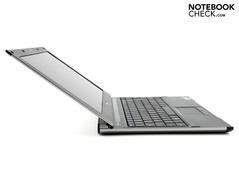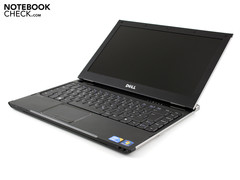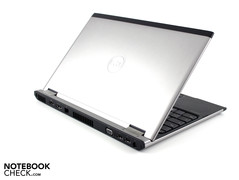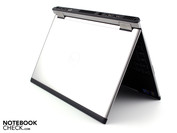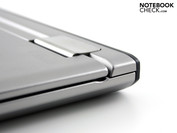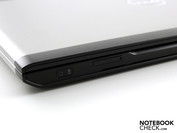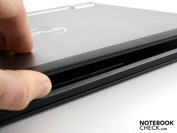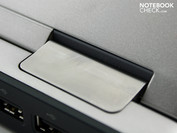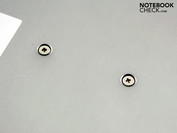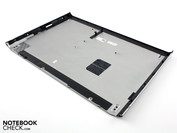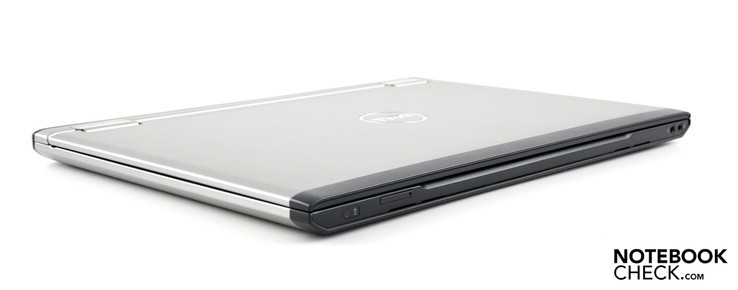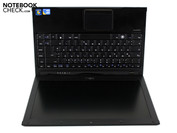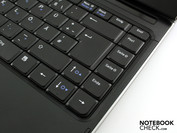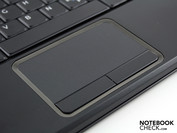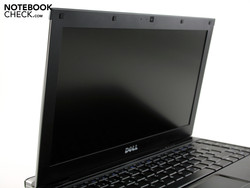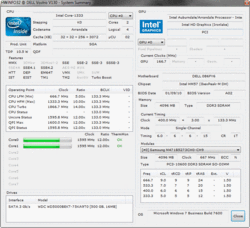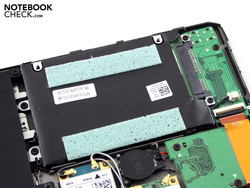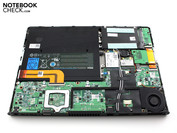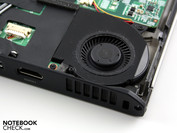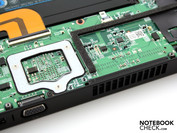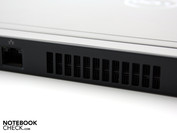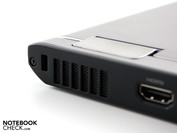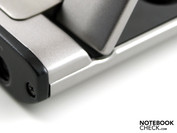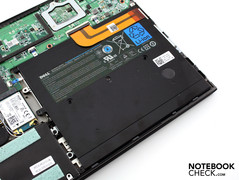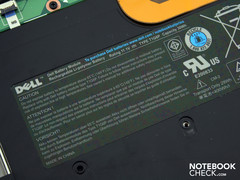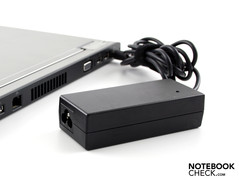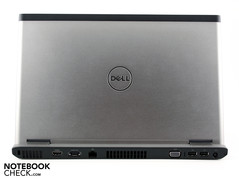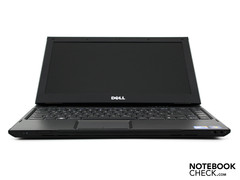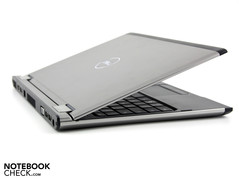Dell Vostro V130 short test
The predecessor of our current test unit appeared on the market at the beginning of 2010. The Vostro V13 provided Penryn, low voltage performance in a slim, 13.3“ housing. The 4 hour battery life (WLAN-Test), didn’t exactly knock us off our feet, but the high quality finish and excellent ergonomics were quite impressive.
Today, on the 30th of November 2010, Dell has decided to unveil its successor to the masses. The Vostro V130, kicks off with an up to date chipset (Intel HM57), Arrandale processor (Core i5-470UM), and an improved cooling system.
Dell sent us a pre-production V130, which is why we will wait before we do any thorough testing. The few specifications that we can offer concerning battery life, performance and ergonomics therefore only apply to this pre-production model. We will report on the final figures in a later test.
Case and Design
The laptop is made completely out of aluminum and consists of a removable base plate, a top cover and lid. The top cover (palm rest), is painted, as is the frame around the TFT. The only plastic components are those which hold the motherboard, hard drive, battery and fan together.
The high level of rigidity is impressive for a thin subnotebook (max. height 19.7 mm). A reason for this is the bulky edge behind the lid which houses the metal hinges. They hold the screen in place, and move only when shaken violently. At 140 degrees, the maximum opening angle is barely influenced by the metal edge. A rubber buffer in the hinge ensures a solid yet dampened feeling when the limit is reached.
In order to open the display one only needs one hand. We noticed that the lid offered almost no resistance for first the 2 centimeters. This is due to a well proportioned resistance in the hinge. At this point one can hold the lid properly and one will notice that more force will also be required for the remainder of the distance.
The weight of 1.67 kilograms cannot compete with the Apple MacBook Air (1.33 kilograms), or the Adamo XPS (1.43 kilograms). This isn’t a downside however as the additional rigidity more than makes up for it. One won’t have to add the weight of a "second skin" case as the Vostro V130 simply won’t need something like that.
The second reason for the weight is the inbuilt Lithium-Ion battery with 30 Watts. This has not changed in relation to its predecessor.
Features
We often criticize the lack of interfaces on standard subnotebooks. The most common argument is that it reduces the amount of messy cables on the work surface. The V130, just like its predecessor, provides a full complement of interfaces at the back of the unit. The aluminum surround at the front is only broken up by the card reader (MS, MS pro, SD, MMC, SDHD). The Express Card/34 slot had to be removed in favor of a slightly larger motherboard. The cooling system was moved which was probably also a reason why the Express Card slot had to be removed.
The connectivity panel at the back was completely redesigned. As it now contains both the fan intake (left) and outlet (middle), the eSATA, VGA, USB, Ethernet and power supply had to find new positions. An HDMI port was added, as well as two additional USB 2.0 Ports. All in all the Vostro received a substantial upgrade as far the interfaces are concerned. The Express Card 34, might be a loss, but three USB ports and an HDMI are a real plus.
Business features such as a Trusted Platform Modul, finger print reader or docking station option aren’t available, however.
Communication
The 13.3" laptop is equiped with all the bells and whistles one may need. Gigabit Ethernet (Realtek) and draft-n WLAN (Dell Wireless 1702), are obligatory these days. Bluetooth v3.0 + High Speed is included and a Dell 5540 EM820U HSPA-Modem provides mobile internet access when on the road. The Sim Card is inserted at the front of the unit. To make sure that the Sim Card is not accidentally removed, it can only be ejected using the tip of a paper clip or similar utensil.
Warranty
Depending on the offers, the V130 models come with one year collect and return repair service. Upgrades are of course possible and include 3 years on-site service, a 5 year basic warranty and several individual solutions.
Input Devices
The keyboard is easy to type on but it isn’t any better than the average consumer laptop. The 19mm frame (16mm typing surface), uses up the entire width of the chassis. The edge of the right hand side even has enough room for picture and position keys. The layout is pretty generous. The arrow keys could have been closer to the palm rest however.
The keyboard is pretty solid but the Enter key is prone to some noticeable, unwanted movement. The key feels vague and loose. Generally the strokes are of medium length but the pressure point isn’t always noticeable, which doesn’t give very good feedback while typing.
The touchpad is a much better performer and doesn’t really offer any reason for complaint. Actually, the contrary is true. The Multi-Touch Pad has keys which are pleasantly light, as well as a well defined key stroke. Chunky borders frame the ample surface. The soft keys barely make a sound and allow for a fast and comfortable "clicking“ experience.
Display
With the exception of its matt finish, this pre-production Vostro V130 has a typical consumer level display panel. As the specifications may change by the time production starts we will not perform any measurements concerning the brightness, contrast or color pallet. The specs on the 16:9 HD display (1.366 x 768 pixels), were also not readable. The colors are lacking both depth and vibrancy. They look faded. We conclude that this pre-production unit has very low contrast values, which would be the norm for a subnotebook aimed primarily at office use.
Companies would generally prefer the traditional 4:3 layout (documents, tables and databases which are oriented vertically). The Vostro V130 will only have an HD Ready display as standard.
The narrow viewing angles are also an indication that we are dealing with an 08/15 consumer level TFT. Horizontally distortions can already be found at a viewing angle of around 40 degrees. The brightness is stable up until 80 degrees, up to which point the text can be clearly read as well. Vertically one notices distortions from 10 degrees and up (darkening from underneath, and cross-fading from the top). This could mean a lot of adjustments while on the road.
Performance
The processor in our pre-production Vostro is not the traditional i5-520UM (Low Voltage). Instead it is a brand new Core i5-470UM (32-nm). At 2x1.33 GHz and with a TDP of 18 Watts (UM-Models), this is your typical low voltage product. The turbo function can boost performance up to 1.86 GHz for use in certain applications. This only applies to the single core applications, for the others the multi core with Hyper Threading (four threads), kicks in.
CPU options Vostro V130
Intel Celeron Processor ULV U3400 (2M Cache, 1.06GHz, 800 MHz FSB)
Intel Core Processor ULV i3-380UM (3M Cache, 1.33GHz, 800 MHz FSB)
Intel Core Processor ULV i5-470UM (3M Cache, 1.33GHz, 800 MHz FSB)
Like all Core i5 processors, this 470UM also has a DDR3 memory controller and an integrated Intel GMA HD graphics chip. The CPU is not specifically made for business applications and there is no support for the AES New Instructions. There is only one slot available for RAM and this is filled with a 4GB (PC3-10600 SDRAM), chip as standard.
In order to judge the performance of the Core i5-470UM we refer back to our results in the CPU benchmark database.
The Cinebench R10 64 Bit "single core rendering" awarded the 470UM around 2.400 points. This is roughly the same performance of a Core i5-520UM (2x1.06GHz, 2400 points), but less than a i3-330M (2x2.13 GHz, 2.900 points), and the i5-430M (2x2.26 GHz, 3.400 points). The 470UM and 520UM have an identical turbo rating of 1.8 GHz.
Compared to its predecessor in the V13 the Vostro V130 should offer substantially better performance. At the time, the Intel Core 2 Solo SU3500 (1x1.4 GHz), only achieved 1.468 points (32Bit), which made it a low performing CULV subnotebook processor. The SL9600, Core 2 Duo LV processor (6MB Cache, 2.13 GHz), which was used in up market subnotebooks at the time, managed 2.726 points in the Cinebench R10 Single-Test.
The current Intel Core-i architecture gets high marks when using all available threads (Hyper Threading: 2 cores + 2 virtual cores). The Cinebench R10 Multi-Test (64bit) racks up 4.800 points (comparison: 520UM = 4.179; i3-330M = 6.600; i5-430M = 7.800). This time around the Core 2 Duo SL9600 actually has roughly the same performance achieving 4.815 points. The reason for this, is that the SL9600 has 2 threads, where as the 470UM has 4.
Despite its limited height, there is still enough room for a 2.5” notebook HDD from Western Digital. Unser Our test unit had a 500GB HDD with 7.200 RPM of which the background noise was as noticeable as the quick access times. (see Crystal Disk Mark). There is also a 128 GB SSD option.
Hard drive options - Vostro V130
250 GB 5400 rpm SATA (not in APJ)
320/500/640 GB 7200 rpm SATA (640 GB not in APJ & DAO)
128 GB SSD (not in APJ)
Free fall sensor on mother board (standard)
Emissions
The layout of the cooling system was completely redesigned. It even has its own name: Intel Advanced Cooling Technology - Hyperbaric Cooling. This will apparently keep surfaces cooler, while also reducing background noise.
Traditional cooling systems use the fan to move hot air out of the housing. This is why the fan kicks in when the CPU exceeds a certain temperature. The residual heat is conducted through a copper heatpipe to a heatsink where the heat is removed from by a stream of air produced by the fan which is located next to it.
The fan in the Hyperbaric Cooling sucks in the air which is first pumped through a channel on the mother board before it reaches the heatsink. Because of this, other components within the system are cooled before the air reaches the heatsink. The copper heatpipe and heatsink are still the chosen method of cooling the CPU.
In our undemanding office „stress test“, our test unit remained audible, but unobtrusive. This is despite the fact that the fan is actually switched off. The background noise one can hear comes from the fast turning HDD (7.200 RPM). The noise level is not at all obtrusive but it is present all of the time. Those who are looking for a silent system should select the SSD option.
We created a high load using Prime95 (CPU, Multi-Core Test), which only made the fan run at an intermediate and constant speed. It was interesting to see how quickly the fan reduced its speed after the test (generating less noise than the hard drive).
The Vostro V130 heated up significantly during the long stress tests (Prime95, Multi-Core) but this was only noticeable on the one centimeter wide patch of aluminum directly behind the lid. (max. 39.7 degrees Celsius). At idle, this spot only reached only 32 degrees.
We did not take the unit apart completely (remove the motherboard), but we are assuming that the heatsink is fixed to the housing at this particular point. This would also explain the relatively long time it took for the fan to switch off during this test.
At the same time we registered a maximum of 30 degrees (top left), down to 24 degrees (top right), on the worksurface. The baseplate reaches 37 degrees directly under the exhaust vent. Other areas range between 27 und 33 degrees. All in all the temperatures are very respectable for this type of test.
Battery Life
Dell decided to use the same Lithium-Ion battery found in the V13 (6 cells, 30Wh). As this battery is integrated, there are no upgrade options. The manufacturer specifies a battery life of 4:21 hours under normal working conditions.
As this is a pre-production model we decided not to test the exact time using the BatteryEater-Tool. In our test which consisted of browsing the web, with lots of idle time (energy saving, stand-by, WLAN, and display dimming switched off) we managed to record a time of 3:10 hours. The lowest brightness setting on the display was too dark to work with (even indoors), so we chose an intermediate setting.
At idle the V130 ran for 4:11 hours (energy saving, WLAN and stand-by, elimination set to minimum). This average performance is what we expected considering the increased performance and limited battery capacity. The final version will probably not perform any better unless Dell increases the battery capacity or tweaks the power saving settings).
Verdict
Dell made the right choices when creating this new model, and has turned something that was already good, into something that is even better. Compared to its predecessor, the Vostro V13, this unit also features a rigid, high quality housing, a matt display and mobility thanks to the HSDPA-Modul. In addition there are other notable attributes such as the excellent ergonomics (heat and noise levels).
An important drawback of the V13 was rectified by switching to the Core i5-470UM processor. With the V130 now equipped with Turbo-Boost und Hyper Threading one can no longer complain about a lack of performance. The performance is increased further thanks to the 7.200 rpm HDD, or with the 128GB SSD option. Also the new HDMI port is a sensible addition to the interfaces and enables the connection to a high resolution monitor.
The battery life has not improved when compared to the V13 (WLAN 3:10 hours). The system performance has increased however. Because of the limited battery capacity of 30Wh we are not expecting any significant improvements for WLAN and idle times when the final production model is launched. We will review this point when we do our detailed report after the official product launch.


 Deutsch
Deutsch English
English Español
Español Français
Français Italiano
Italiano Nederlands
Nederlands Polski
Polski Português
Português Русский
Русский Türkçe
Türkçe Svenska
Svenska Chinese
Chinese Magyar
Magyar
